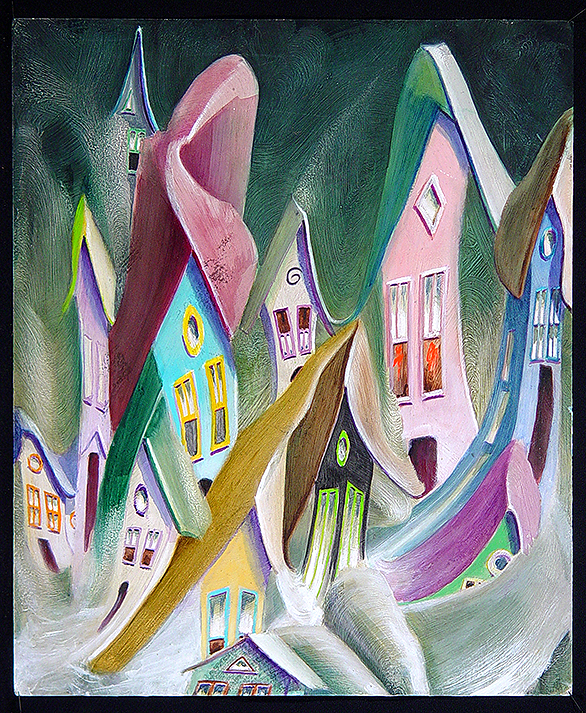Mindquake - The Real and Surreal
By: Jenny Pace - Page One
A child of postwar Southern California, Christopher Moses began at an early age to pursue a form of expression which was true to his view of the world. He was born with an eye condition which left him cursed with the gift of double vision, a state which only heightened his keen awareness of the dynamism of the natural and physical worlds. Moses describes as a turning point in his young life the instant in which a bird flew in front of him on an otherwise lackluster afternoon. From that moment, by his own admission, he was never bored again. The world around him, vibrant with forces seen and unseen, had only just begun to offer itself up to his unrelenting examination.
Moses left California to attend college in Oregon and remained there for eighteen years. As a student he studied Jungian psychology and painted and drew only for pleasure or entertainment. Soon, however, he began to create as a means to express or understand the often bewildering images and ideas which coursed through his mind. For Moses, documenting the visions of his imagination comes first, and from them a story or narrative later emerges. Though he took art classes as a child, he finds lived experience to be his greatest instructor, his driving influence.
Living for the past decade and a half in an isolated fishing village on Mexico’s Pacific coast, Moses’ vision and his own commitment to it are further informed by the legacy of indigenous and Latin art with which he is surrounded. He has long sought out the expressions of societies far removed from his own. Moses counts among his major influences the vivid artistry of the many cultures he more encountered while traveling overland from Istanbul to Kathmandu in the early seventies. More recently, he has forged a sacred kinship with “outsider” artists of the Deep South.
Recently included in the American Visionary Art Museum’s High on Life: Transcending Addiction, Moses readily acknowledges and embraces the influence of psychedelic and hallucinatory agents on both his life and his art. Seeking an expression for the intangible, he finds most of his creative energy is consumed by a drive to capture and thereby understand his own lived reality, to document the insights witnessed by his uniquely “deformed” eye.
Moses’ work is marked simultaneously by an eerie stillness and an implied dynamism, much like that which defines the style of Surrealist masters Giorgio De Chirico and René Magritte. He captures a sort of cosmic snapshot, making visual the last nanoseconds before a particular image comes into clear focus inside the human brain. The movements of atoms and molecules which the scientist studies under the microscope form the crucial elements of Moses’ everyday reality.
He has in recent years been concerned with exploring several recurring themes and images which belie his ongoing passion for capturing the effects of sensory experience. His persistent vision problems have perhaps contributed to a particular fascination with depicting the eye. A subject which the artist often revisits and reconsiders involves an illustration of a field of eyes in various shapes, colors and sizes bound by undulating bands of what seems to be a sort of human musculature.
Upon first glance these eyes appear to be relics saved from some unknown martyr, though closer inspection reveals them to be representative of the many vantage points available to a single being. In Moses’ world, perception involves not just the moment in which an image is captured, as the Analytic Cubists suggested, but those leading up to it. He visualizes for the rest of us the realm beyond our usual perception. His concern lies with that which is all around us, yet invisible.
More: Page Two

A SUDDEN SHIFT
Acrylic and Gesso on Paper - 17 x 14
Houses
